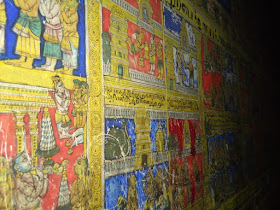Athmanatha Swamy Temple,
Avudaiyarkoil – Religious Significance
Atheetha Sabha:
The Temple is also known as Atheetha Sabha as it has six Sabhas, the Kanaka Sabha,
Chit Sabha, Sat Sabha, Ananda Sabha, Ratna Sabha and Deva Sabha in comparison
to five Sabhas at Chidambaram, each of these halls is named after Shaivite
theological terms. These halls have exquisite carvings. It is believed
that Manikkavasakar himself built these
Sabhas and covered the Sabhas with 21600 plates of copper. Mahamandapam
represents Sath, Ardhamandapam the Chith and the sanctum sanctorum the
Anandha.
Munnothioruvar:
As
at Chidambaram and Thiruvanaikoil,
here Vedic rituals
are performed, unlike the Sivachariyar or Adhisaivar temples who follow Agama rituals. In this case the
temple is administered by Nambiar Brahmins,
a class of Vaidheega Brahmins said to be descendants of Rowshayadana, a saint
who originated from Agni, and were taught the Vedas by Athmanathar
himself. They are said to number three hundred and are also called
Munnothioruvar.
This
agnivesha is also famous author of a magnificent ancient medical treatise
called agnivesha Kalpasutra spanning 77000 verses that discusses treatment for
many types of diseases and medicines. The duties connected with the temple are
looked after by Nambiar brahmins, Sivacharya, Adyana Bhattar, Saiva Odhuvars,
Kothanar and Kambar Kula Ocharkal. Nambiar Brahmins are the descendants of
Munnothioruvar Brahmins.
Temple specialty:
Thetemple renowned for Moorthy (Athmanathar), Sthalam (Siva sthalam), Theertham
(Agni Theertham), Vanam (Kurundha Vanam), Puram (Siva Puram) and Thondar
(Manickavasagar).
South facing Temple:
While
Shiva temples are generally facing east, Avudaiyarkoil temple is facing
south. As Lord Shiva plays the Guru part teaching Saint Manikkavasakar as
Lord Dakshinamurthy, the temple is facing south, it is explained. The
other Shiva temple facing south is Lord Kadambavana Nathar temple in Karur.
Nandi, flagstaff and Balipeedam:
The temple does not have Nandi, flagstaff and Balipeedam is conspicuously absent as
both Lord and Mother are formless.
Practice of blowing of Conch:
Instead
of playing Nadaswaram, Melam and Berigai, the blowing of conch, ringing of bell
and Thiruchinnam is in vogue.
Arati:
Generally,
the Arati offered to deities in temples are shown to devotees who touch it and
place their hands in eyes. But the Arati plate in Avudaiyarkoil Lord is
not brought out of the sanctum sanctorum as Lord by himself is a Jyoti.
Worshipping Lord or the Arati makes no difference.
Worship during eclipse time:
Contrary
to traditional absence of pujas in temples during eclipse time, it is otherwise
in Avudaiyarkoil temple conducting the six-time puja as usual even during such
occurrence. The philosophy is that eclipses cannot stop the pujas for
Shiva having no beginning nor an end – no Aadhi – no Andham.
Offerings:
The
daily rituals for the third kala puja include the offering made to the God
during puja – the steaming par boiled rice is heaped on the slab in front of
the Garbha Griha like miniature mound, and around it are placed a huge variety
of snacks - Thenkuzhal, Vada, Athirsam, Sooyam, Pittu and Dosai. The steam that
rises from these is the offering to the Lord.
Utsava Idol:
Utsava
Idol of the temple is the Saint Manikkavasakar, not of the Lord
Shiva. This is a special feature in the Hindu religious practice in Tamil
Nadu.
Idols in standing posture:
Representing
the rule that disciple should not sit before Guru but only stand,
Manikkavasakar, Chokka Vinayaka, Muruga and Veerabhadra are standing before
their Guru (Lord Athmanathar).
Forms of Lord Shiva:
Lord
Shiva graces in three postures in this Temple as formless, form-formless as the
Kurundha tree and in form as Manikkavasakar. As the Kurundha tree is
praised as Lord, 108 conchs Abishek (Sankabisheka) is offered on Mondays of
Karthikai month (November-December).
Deepams:
There
are three Deepas (lamps) lit in the sanctum sanctorum behind the presiding
deity in white, red and green as the three eyes of Lord Shiva representing Sun
(white), Agni (red) and Moon (green). As Lord is formless, these three lamps
are lit. Every entrance in the temple has Deepas (lamps) in specific
numbers. The Thiruvasi (a metal frame in upside U shape around Lord Shiva
has 27 lamps representing 27 stars, the two nearby the Jeevathma - Paramatma
philosophy, 5 representing the five arts, 36 representing many philosophies, 51
letters. 11 mantras and 224 world divisions. Those facing planetary
problems offer ghee for lighting the Deepas around the Thiruvasi.
Kodungai Carvings:
Avudaiyar Koil is famous for the art of Kodungai carving, the work done under the stone
that forms the sun shade or overhang of the roof. It usually sits on top of the
beam stone and is a superb example of the craft of the 9th century
artisans.
Thiruvasagam:
One of
the sacred books of Tamil Saiva
Siddhanta, Manikkavacakar’s Thiruvasagam,
originated from this shrine.
Importance of Number “6”:
The
most interesting feature about Avudaiyar Koil is that the number six pervades
in the name of the presiding deity, in the number of items that are presented
as naivedana, Aaru kala puja, the number of Mandapams (Sabhas), six groups of
archakas, number of iron rods inside Kodungai, and above all in the 51 Pathigams
of Thiruvasagam. Based on six adharams and six adhwas, the sabhas and mandapams
have been constituted.















































